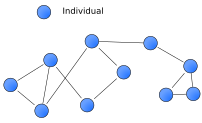 by Wolfgang Staudt
by Wolfgang Staudt
The science exchange:
[Via Science in the open]
How do we actually create the service that will deliver on the promise of the internet to enable collaborations to form as and where needed, to increase the speed at which we do science by enabling us to make the right contacts at the right times, and critically; how do we create the critical mass needed to actually make it happen? In another example of blog based morphic resonance there has been a discussion a discussion over at Nature Networks on how to enable collaboration occurred almost at the same time as Pawel Szczeny was blogging on freelance science. I then hooked up with Pawel to solve a problem in my research; as far as we know the first example of a scientific collaboration that started on Friendfeed. And Shirley Wu has now wrapped all of this up in a blog post about how a service to enable collaborations to be identified might actually work which has provoked a further discussion.
[More]
Open Science is really in the very early stages. It may very well evolve into an important adjunct for research. Collaborations are the prime driver of much of today’s science.
Collaboration is difficult in some organizations. Without it, they will not be able to effectively solve the difficult questions in science today. The organizations that can harness effective collaborations will survive and flourish.
Currently, collaborations are usually set up using well known social networking skills honed through years of experience. Who you know is important. What Open Science holds the potential for, when it comes to collaborations, deals with who you don’t know.
OS can leverage an online community so that connections can be made that would have been difficult or impossible if face time was required. However, it will take a little work, like porcupines mating, to make this really effective.
Part of the reason for this is trust. Science has some free loaders, people who take short cuts. Not many but they can degrade interactions until trust is established. which takes a little time. Reputation is an important part of this trust.
There are many examples of peer reviewers abusing the process and scooping someone on a paper that they held up in review, giving the reviewer time to replicate the work in his lab and submit a paper.
Grant proposals have been abused in a similar fashion. Researchers have altered data in order to fit a preconceived hypothesis. Collaborating with such people is a possible danger without more information.
So trust and reputation will have to be a part of OS, particularly since the participants may not meet face to face. But reputation and trust are a common problem with many Web 2.0 approaches.
One way Web 2.0 surmounts this is the very openness and transparency that gives it power. Ebay, for example, would not work if people did not trust the seller to have the item and the buyer to have the cash. Being able to see how each rates the other help establish trust.
Research has shown that what is important in human social networks is not that the network prevents cheats or freeloaders from existing. It is that the network has a method for identifying them and expelling them from the network if they fail to change.
Now OS will not be like Ebay, which is a site of commerce. But the power of many eyeballs watching the interactions will help apply social norms to the most egregious behavior. A reputation lost in the open like this will be very difficult to untarnish.
Another important aspect of scientific collaborations is power, a very human trait. Scientists with power (i.e. large, well funded labs) sometimes have a very different view of a collaboration than those with a small lab and a single grant. People often tend to confuse large and well-funded with innovative.
Remember well funded does not always mean cutting edge investigations of important questions. Sometimes it means doing what everyone knows will work, just more of it with greater efficiency. Risk is many times found in the smaller labs, not the larger, something also seen in corporations. The unwillingness to take a risk, found in many large organizations, often make collaboration with smaller, risk-taking groups problematic.
But on the Internet, this sort of power is defused somewhat. There is a leveling effect, allowing many more researchers to have an equal voice. On the Internet, no one knows you are a dog. They also may not know whether you have a lab of 40 researchers and $10 million in grants. What will be important are your ideas and how you treat others in the network.
So, watch as this discussion happens out in the open, as it should. Become part of it if you can.
Technorati Tags: Open Access, Science, Social media, Technology, Web 2.0








